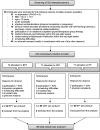Bouldering psychotherapy is more effective in the treatment of depression than physical exercise alone: results of a multicentre randomised controlled intervention study
- PMID: 32164679
- PMCID: PMC7066840
- DOI: 10.1186/s12888-020-02518-y
Bouldering psychotherapy is more effective in the treatment of depression than physical exercise alone: results of a multicentre randomised controlled intervention study
Abstract
Background: Recent scientific studies have suggested that climbing/bouldering is effective in alleviating depression when the comparison group was a waitlist control group, even when physical activity and other therapeutic approaches were controlled for. In the present study, we aimed to investigate the effectiveness of a manualised psychotherapeutic bouldering intervention for depressed individuals, compared with an active control group performing physical exercise alone.
Methods: In a multicentre randomised controlled intervention trial, 133 outpatients with depression were assigned to either a bouldering psychotherapy (BPT) group or a home-based supervised exercise programme (EP). Severity of depression as the primary outcome was assessed at baseline and directly after a ten-week intervention period using the Montgomery-Åsberg Depression Rating Scale (MADRS). Secondary outcomes included anxiety, coping skills, self-esteem, body image, and interpersonal sensitivity. We applied t-tests to test for differences within the groups (t0 vs. t1) and between the BPT and the EP and a multiple regression analysis with the post-intervention MADRS score as the dependent variable. The robustness of estimates was investigated with a sensitivity analyses.
Results: Patients in the BPT group showed a significantly larger decrease in depression scores compared with the EP on the MADRS (drop of 8.4 vs. 3.0 points, p = .002, Cohen's d = 0.55). In the confounder-adjusted regression analyses, group allocation was found to be the only significant predictor of the post-intervention MADRS score (β = - 5.60, p = .001) besides the baseline MADRS score. Further significant differences in change scores between the BPT and the EP were found for anxiety (p = .046, d = 0.35), body image (p = .018, d = 0.42), and global self-esteem (p = .011, d = 0.45).
Conclusions: The study provides evidence that the manualised BPT is not only effective in alleviating depressive symptoms but even goes beyond the effect of mere physical exercise. Based on these findings, the BPT should be considered as a complementary therapeutic approach.
Trial registration: Trial identification number: ISRCTN12457760: Study KuS (Klettern und Stimmung - Climbing and Mood) combined boulder and psychotherapy against depression, registered retrospectively on July 26th, 2017.
Keywords: Bouldering; Depression; Physical exercise; Psychotherapy.
Conflict of interest statement
The authors declare that they have no competing interests.
Figures



Similar articles
-
A German climbing study on depression: a bouldering psychotherapeutic group intervention in outpatients compared with state-of-the-art cognitive behavioural group therapy and physical activation - study protocol for a multicentre randomised controlled trial.BMC Psychiatry. 2019 May 17;19(1):154. doi: 10.1186/s12888-019-2140-5. BMC Psychiatry. 2019. PMID: 31101097 Free PMC article. Clinical Trial.
-
Bouldering psychotherapy is effective in enhancing perceived self-efficacy in people with depression: results from a multicenter randomized controlled trial.BMC Psychol. 2021 Aug 26;9(1):126. doi: 10.1186/s40359-021-00627-1. BMC Psychol. 2021. PMID: 34446114 Free PMC article. Clinical Trial.
-
Bouldering psychotherapy is not inferior to cognitive behavioural therapy in the group treatment of depression: A randomized controlled trial.Br J Clin Psychol. 2022 Jun;61(2):465-493. doi: 10.1111/bjc.12347. Epub 2021 Nov 17. Br J Clin Psychol. 2022. PMID: 34791669 Clinical Trial.
-
Novel Augmentation Strategies in Major Depression.Dan Med J. 2017 Apr;64(4):B5338. Dan Med J. 2017. PMID: 28385173 Review.
-
Physical activity, exercise, depression and anxiety disorders.J Neural Transm (Vienna). 2009 Jun;116(6):777-84. doi: 10.1007/s00702-008-0092-x. Epub 2008 Aug 23. J Neural Transm (Vienna). 2009. PMID: 18726137 Review.
Cited by
-
The Origin, Application and Mechanism of Therapeutic Climbing: A Narrative Review.Int J Environ Res Public Health. 2022 Aug 6;19(15):9696. doi: 10.3390/ijerph19159696. Int J Environ Res Public Health. 2022. PMID: 35955052 Free PMC article. Review.
-
A psychosocial bouldering intervention improves the well-being of young refugees and adolescents from the host community in Lebanon: results from a pragmatic controlled trial.Confl Health. 2024 Sep 14;18(1):56. doi: 10.1186/s13031-024-00615-3. Confl Health. 2024. PMID: 39277748 Free PMC article.
-
A Comparison of Acute Effects of Climbing Therapy with Nordic Walking for Inpatient Adults with Mental Health Disorder: A Clinical Pilot Trial.Int J Environ Res Public Health. 2022 Jun 1;19(11):6767. doi: 10.3390/ijerph19116767. Int J Environ Res Public Health. 2022. PMID: 35682348 Free PMC article. Clinical Trial.
-
Affective Responses to Both Climbing and Nordic Walking Exercise Are Associated With Intermediate-Term Increases in Physical Activity in Patients With Anxiety and Posttraumatic Stress Disorder - A Randomized Longitudinal Controlled Clinical Pilot Trial.Front Psychiatry. 2022 Jun 9;13:856730. doi: 10.3389/fpsyt.2022.856730. eCollection 2022. Front Psychiatry. 2022. PMID: 35757205 Free PMC article.
-
Climbing as an Add-On Treatment Option for Patients with Severe Anxiety Disorders and PTSD: Feasibility Analysis and First Results of a Randomized Controlled Longitudinal Clinical Pilot Trial.Int J Environ Res Public Health. 2022 Sep 15;19(18):11622. doi: 10.3390/ijerph191811622. Int J Environ Res Public Health. 2022. PMID: 36141895 Free PMC article. Clinical Trial.
References
-
- Blumenthal JA, Sherwood A, Babyak MA, Watkins LL, Smith PJ, Hoffman BM, O'Hayer CV, Mabe S, Johnson J, Doraiswamy PM, et al. Exercise and pharmacological treatment of depressive symptoms in patients with coronary heart disease: results from the UPBEAT (understanding the prognostic benefits of exercise and antidepressant therapy) study. J Am Coll Cardiol. 2012;60(12):1053–1063. doi: 10.1016/j.jacc.2012.04.040. - DOI - PMC - PubMed
-
- Blumenthal JA, Babyak MA, O'Connor C, Keteyian S, Landzberg J, Howlett J, Kraus W, Gottlieb S, Blackburn G, Swank A, et al. Effects of exercise training on depressive symptoms in patients with chronic heart failure: the HF-ACTION randomized trial. Jama. 2012;308(5):465–474. doi: 10.1001/jama.2012.8720. - DOI - PMC - PubMed
-
- Robertson R, Robertson A, Jepson R, Maxwell M. Walking for depression or depressive symptoms: a systematic review and meta-analysis. Ment Health Phys Act. 2012;5(1):66–75. doi: 10.1016/j.mhpa.2012.03.002. - DOI
Publication types
MeSH terms
Associated data
Grants and funding
LinkOut - more resources
Full Text Sources
Medical

